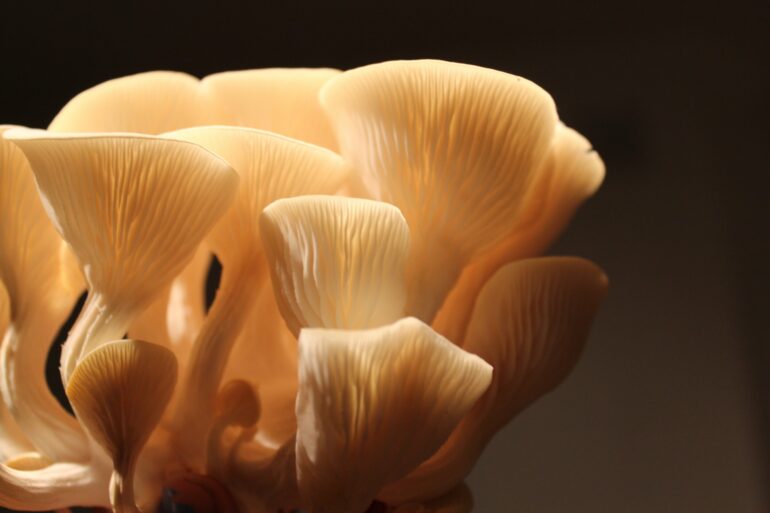Researchers from The University of Sydney have developed a biological growing process that uses mushrooms to turn organic waste into compostable products as a low-cost, sustainable solution to plastics.
University of Sydney academics have brought design, technology and life sciences together to grow everyday products using unique properties of edible mushrooms.
Their paper, recently published in the Proceedings of the 2023 CHI Conference on Human Factors in Computing Systems, was authored by a multi-disciplinary team led by Dr. Phillip Gough, Biodesign Program Director at the School of Architecture, Design and Planning and Dr. Anusha Withana from the School of Computer Science and Sydney Nano Institute, comprising Associate Professor Michael Kertesz from the School of Life and Environmental Sciences and Praneeth Perera from the School of Computer Science.
Their work presents an approach for growing sustainable myco-materials—a mixture of mushroom spawn and waste matter such as sawdust and cardboard—into 3D forms of everyday products. By using an interactive software and biodesign process—that takes a complex design and turns it into a mold—they essentially create a cast of the living material that can produce products.
“We’ve had success with a ‘grow-your-own’ mushroom kit, added coffee ground waste from the local café, and then 3D printed detailed molds to form the material into interesting and useful designs,” said Dr. Philip Gough, who co-led the research team with Dr. Anusha Withana.
“It’s lightweight and feels like paper, so it’s interesting for designers. Being compostable, it’s a sustainable alternative to plastic, which will last in the environment long after the technology is obsolete. Perhaps one day the cover on your smart home assistant and other electrical devices will be made from a material that doesn’t go to landfill once you’ve finished using it, but into your garden.”
The research looks at how designers can utilize the natural abilities of edible mushrooms in the design process. Some mushrooms, such as the oyster variety, which can be found at the grocery store, or medicinal Reishi mushrooms, can be used to create new materials. These mushrooms will bind together raw, organic waste matter in their network of roots as they grow, creating structures known as mycelium networks. If the matter is dried before growing a mushroom, mycelium can be used to form a leather-like fabric, or a light, rigid material that can be molded into various shapes.
The researchers have cast molds of simple shapes such as spheres, a teapot and a rabbit, and then developed the process further into more complex, practical designs that make use of the mushroom’s natural abilities. Mycelium can also be grown around integrated electronics—for example, researchers showed a case where this sustainable approach was used to grow a flowerpot with sensors to automatically monitor and report the soil conditions of the plant.
“We used a ‘material first’ design approach—creating prototypes based on the material’s unique properties. For example, it insulates well, so we made a coffee cup holder. We also made a textured pot for plants that will decompose when the plant is ready for a larger pot. We also show that myco-materials can also be molded to house electronic devices, such as smart speakers, ” Dr. Philip Gough said.
“When a plastic housing of common technology breaks (maybe the dog chewing the TV remote) it’s almost impossible to repair yourself, since you can’t make plastic components at home. Myco-materials open opportunities for self-repair and DIY, as they can be grown in your home. Broken plastic parts are also waste, and may not be recyclable, but myco-materials can be composted.”
“Our process can be used by anyone in their own home without any specialized biology lab equipment. For instance, we show a way to replace expensive lab equipment with a cheap blender, pressure cooker and a cool box. And the software pipeline we developed takes all the complexities associated with the process out of the way, so you can transform your designs into growable formats without worrying about all the underlying technical details.
“Another area we work in is creating assistive devices for people living with disabilities or chronic health conditions. We often collaborate with developing countries like Sri Lanka where costs and accessibility of materials is a big problem. This method will allow us to grow things easily with locally accessible organic waste at a fraction of the cost,” he said.
With increasing scarcity of natural resources and environmental concerns, there is a growing interest in sustainable fabrication approaches. In 2021 CSIRO identified waste cardboard and paper as an opportunity for development in the circular economy of Australia.
“Our process presents a huge opportunity. For instance, Australia being a large country, with many remote regions, supply chain is a big problem. I think methods like what we propose can bring a fundamental shift in the way we think about supply chains. In future, your next appliance could be grown out of the organic waste out of your kitchen bin, instead of plastics or metal that needs to be transported from far away,” said Dr. Withana.
“Traditional manufacturing is also energy intensive. Plastics are made from fossil fuels that need to be extracted, transported across the globe, processed, and fabricated,” said Dr. Gough.
“Our work turns this on its head. Myco-materials are energy efficient and can even be a carbon sink. They derive their energy from the waste material, such as sawdust, cardboard or coffee grounds.
“As a designer, it’s interesting to work with a material that grows and expresses some agency in the way it looks. On top of that, we are only just discovering what it is useful for so we can’t wait to see what else we can make,” he said.
The team are now exploring how they can 3D print with myco-materials directly, allowing them to work on a larger scale and use less material overall.
More information:
Phillip Gough et al, Design, Mould, Grow!: A Fabrication Pipeline for Growing 3D Designs Using Myco-Materials, Proceedings of the 2023 CHI Conference on Human Factors in Computing Systems (2023). DOI: 10.1145/3544548.3580958
Provided by
University of Sydney
Citation:
Growing sustainable everyday products using mushrooms (2023, May 17)



